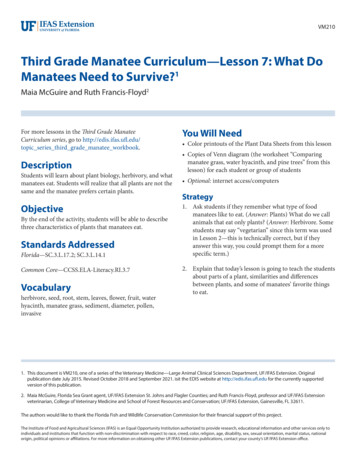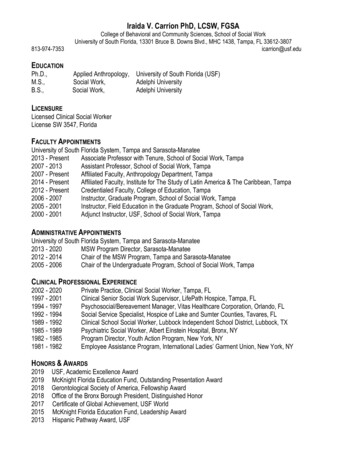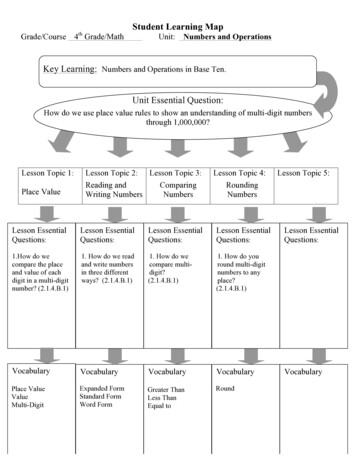
Transcription
VM210Third Grade Manatee Curriculum—Lesson 7: What DoManatees Need to Survive?1Maia McGuire and Ruth Francis-Floyd2For more lessons in the Third Grade ManateeCurriculum series, go to http://edis.ifas.ufl.edu/topic series third grade manatee workbook.DescriptionStudents will learn about plant biology, herbivory, and whatmanatees eat. Students will realize that all plants are not thesame and the manatee prefers certain plants.ObjectiveBy the end of the activity, students will be able to describethree characteristics of plants that manatees eat.Standards AddressedFlorida—SC.3.L.17.2; SC.3.L.14.1Common , seed, root, stem, leaves, flower, fruit, waterhyacinth, manatee grass, sediment, diameter, pollen,invasiveYou Will Need Color printouts of the Plant Data Sheets from this lesson Copies of Venn diagram (the worksheet “Comparingmanatee grass, water hyacinth, and pine trees” from thislesson) for each student or group of students Optional: internet access/computersStrategy1. Ask students if they remember what type of foodmanatees like to eat. (Answer: Plants) What do we callanimals that eat only plants? (Answer: Herbivore. Somestudents may say “vegetarian” since this term was usedin Lesson 2—this is technically correct, but if theyanswer this way, you could prompt them for a morespecific term.)2. Explain that today’s lesson is going to teach the studentsabout parts of a plant, similarities and differencesbetween plants, and some of manatees’ favorite thingsto eat.1. This document is VM210, one of a series of the Veterinary Medicine—Large Animal Clinical Sciences Department, UF/IFAS Extension. Originalpublication date July 2015. Revised October 2018 and September 2021. isit the EDIS website at http://edis.ifas.ufl.edu for the currently supportedversion of this publication.2. Maia McGuire, Florida Sea Grant agent, UF/IFAS Extension St. Johns and Flagler Counties; and Ruth Francis-Floyd, professor and UF/IFAS Extensionveterinarian, College of Veterinary Medicine and School of Forest Resources and Conservation; UF/IFAS Extension, Gainesville, FL 32611.The authors would like to thank the Florida Fish and Wildlife Conservation Commission for their financial support of this project.The Institute of Food and Agricultural Sciences (IFAS) is an Equal Opportunity Institution authorized to provide research, educational information and other services only toindividuals and institutions that function with non-discrimination with respect to race, creed, color, religion, age, disability, sex, sexual orientation, marital status, nationalorigin, political opinions or affiliations. For more information on obtaining other UF/IFAS Extension publications, contact your county’s UF/IFAS Extension office.
3. Use one or more of the following activities to teach theparts and functions of a plant.a.You can show the “life-cycle” animation fromhttp://www.mbgnet.net/bioplants/parts.html. (It’sat the bottom of the page. It can be downloaded asa .gif file and opened in an image viewing programor run from the website.)b.The Great Plant Escape (http://urbanext.illinois.edu/gpe/index.cfm) is a fun interactive/educationalgame from the University of Illinois Extension andis geared towards 4th and 5th grade students. Ifyou have access to a computer lab, you can havestudents do this individually, in teams, or as aclass activity. Case 1 includes an activity labelingthe parts of a plant and questions about plant partfunctions.c.Your students can test their knowledge about edibleplant parts by playing “Supermarket Botany” Have students use a Venn diagram (and the PlantData Sheets) to compare the three different types ofplants using the following characteristics:i.ii.iii.iv.v.vi.vii.viii.ix.Long, thin leavesWide, rounded leavesLarge, showy flowersSmall flowersLives in waterLives on landRoots in soil/sedimentRoots hang loose in waterNo flowers4. Show students pictures of water hyacinth, manateegrass, and pine tree. Do all three types of plants haveroots, stems and leaves? (Answer: Yes, although pinetree “leaves” are called needles.) Point out that manateegrass grows underwater with its roots buried in thesediment. Water hyacinth plants float on the surface ofthe water, with their leaves and flowers in the air andtheir roots hanging down in the water. Pine trees growon land, with roots in the soil.a.Remind students that manatees live in water. Askthe students which of the three types of plants theythink manatees might eat. (Answer: Manatee grassand water hyacinth) Ask the students how plantsget their food. (Answer: They use the sun’s energyto make it.) Explain that animals like manateeshave to get their energy by eating plants.Third Grade Manatee Curriculum—Lesson 7: What Do Manatees Need to Survive?2
Plant Data Sheet: Water hyacinthWhere does it live?Water hyacinth plants float in fresh water. They can be found growing in Florida’s rivers, lakes,and ponds. Their leaves and flowers are in the air, while their roots hang down in the water.What does it look like?Water hyacinth plants have large purple flowers. A single plant can be from a few inches to threefeet tall!What’s special about it?Water hyacinth is an INVASIVE plant in Florida. It was brought here from another country,because people thought it was pretty and wanted to have it growing in their ponds. Unfortunately, it ended up in places like the St. Johns River, where it grows and grows and grows, covering the surface of the water in some places. This means that light cannot get into the water, sounderwater plants cannot survive. Also, boats cannot get through the thick water hyacinth. Nowpeople are not allowed to bring any more water hyacinth into Florida!Figure 2. Water hyacinthCredits: Samuel HuckinsFigure 1. Water hyacinthCredits: UF Center for Aquatic and Invasive PlantsThird Grade Manatee Curriculum—Lesson 7: What Do Manatees Need to Survive?3
Plant Data Sheet: Manatee grassWhere does it live?Manatee grass lives in Florida’s salty water (ocean and bays). It lives completely underwater. Itsroots are buried in the sediment, and its leaves stick up into the water. Manatee grass grows inshallow water—it cannot grow in very deep water.What does it look like?Manatee grass leaves look like green spaghetti! The leaves are rounded and can be rolled in yourhands. Manatee grass has tiny flowers, but they are very difficult to see.Figure 3. Manatee grassCredits: Tracey Saxby, Integration and Application Network, Universityof Maryland Center for Environmental Science (ian.umces.edu/imagelibrary/)Figure 4. Manatee grassCredits: Florida Fish and Wildlife Conservation CommissionThird Grade Manatee Curriculum—Lesson 7: What Do Manatees Need to Survive?4
Plant Data Sheet: Pine treeWhere does it live?There are many types of pine trees, but all live on land and bury their roots in the soil.What does it look like?Pine trees have long, thin needles instead of leaves. Pine trees can be very tall. They do not havetrue flowers, but they make lots of yellow pollen. Pine tree seeds grow inside pine cones.Figure 5. Longleaf pine needlesCredits: Melinda SheltonFigure 6. Longleaf pine coneCredits: Daniel OinesThird Grade Manatee Curriculum—Lesson 7: What Do Manatees Need to Survive?5
Figure 7. Longleaf pine treesCredits: Chris M. MorrisThird Grade Manatee Curriculum—Lesson 7: What Do Manatees Need to Survive?6
Comparing manatee grass, water hyacinth, and pine treesName:Use the photographs and the plant data sheets to help with this activity. Write the letter for each characteristic in the properplace in the diagram below. You can also create additional characteristics if you want.a.b.c.d.e.f.g.h.i.Long, thin leavesWide, rounded leavesLarge, showy flowersSmall flowersLives in waterLives on landRoots in soil/sedimentRoots hang loose in waterNo flowersFigure 8.Third Grade Manatee Curriculum—Lesson 7: What Do Manatees Need to Survive?7
8
9
Pine trees have long, thin needles instead of leaves. Pine trees can be very tall. They do not have true flowers, but they make lots of yellow pollen. Pine tree seeds grow inside pine cones. Third Grade Manatee Curriculum—Lesson 7: What Do Manatees Need to Survive? Figure 6. Longleaf pine cone Credits: Daniel Oines Figure 5. Longleaf pine needles










